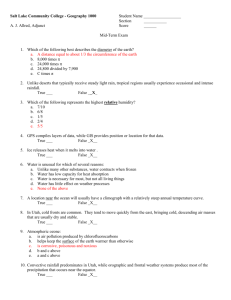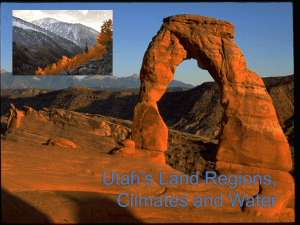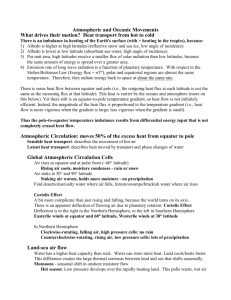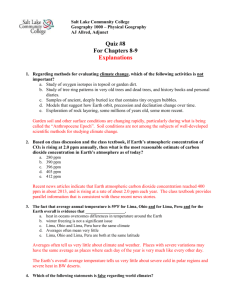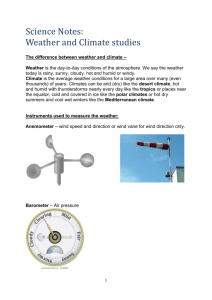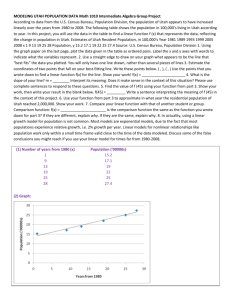Salt Lake Community College Geography 1000 – Physical Geography AJ
advertisement
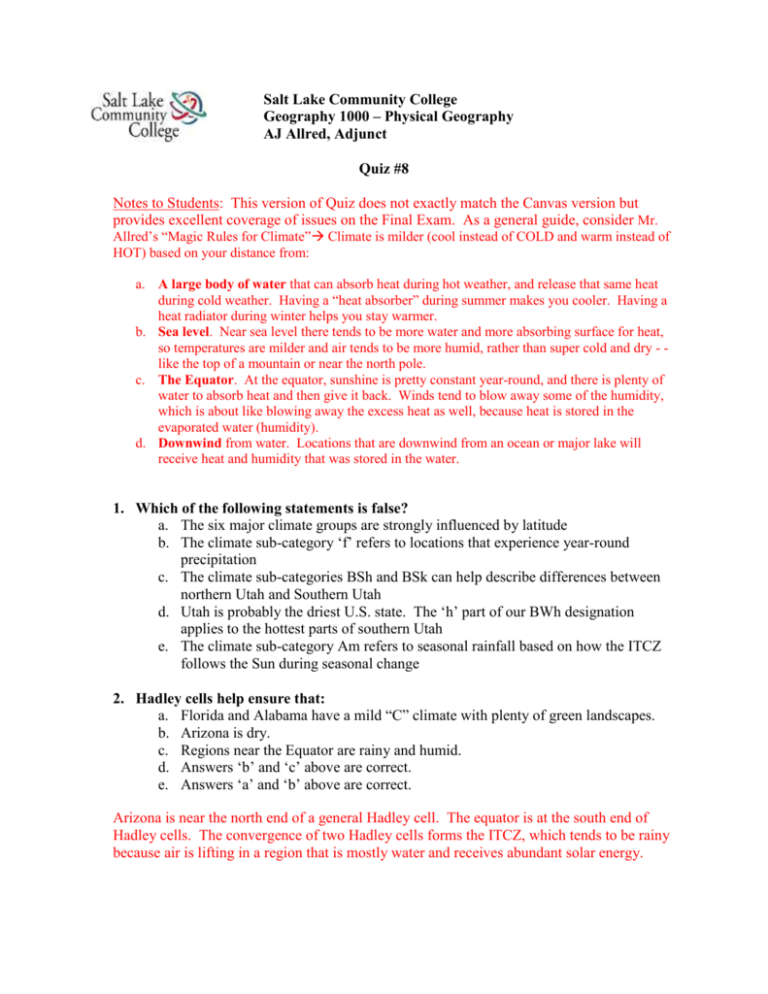
Salt Lake Community College Geography 1000 – Physical Geography AJ Allred, Adjunct Quiz #8 Notes to Students: This version of Quiz does not exactly match the Canvas version but provides excellent coverage of issues on the Final Exam. As a general guide, consider Mr. Allred’s “Magic Rules for Climate” Climate is milder (cool instead of COLD and warm instead of HOT) based on your distance from: a. A large body of water that can absorb heat during hot weather, and release that same heat during cold weather. Having a “heat absorber” during summer makes you cooler. Having a heat radiator during winter helps you stay warmer. b. Sea level. Near sea level there tends to be more water and more absorbing surface for heat, so temperatures are milder and air tends to be more humid, rather than super cold and dry - like the top of a mountain or near the north pole. c. The Equator. At the equator, sunshine is pretty constant year-round, and there is plenty of water to absorb heat and then give it back. Winds tend to blow away some of the humidity, which is about like blowing away the excess heat as well, because heat is stored in the evaporated water (humidity). d. Downwind from water. Locations that are downwind from an ocean or major lake will receive heat and humidity that was stored in the water. 1. Which of the following statements is false? a. The six major climate groups are strongly influenced by latitude b. The climate sub-category ‘f’ refers to locations that experience year-round precipitation c. The climate sub-categories BSh and BSk can help describe differences between northern Utah and Southern Utah d. Utah is probably the driest U.S. state. The ‘h’ part of our BWh designation applies to the hottest parts of southern Utah e. The climate sub-category Am refers to seasonal rainfall based on how the ITCZ follows the Sun during seasonal change 2. Hadley cells help ensure that: a. Florida and Alabama have a mild “C” climate with plenty of green landscapes. b. Arizona is dry. c. Regions near the Equator are rainy and humid. d. Answers ‘b’ and ‘c’ above are correct. e. Answers ‘a’ and ‘b’ above are correct. Arizona is near the north end of a general Hadley cell. The equator is at the south end of Hadley cells. The convergence of two Hadley cells forms the ITCZ, which tends to be rainy because air is lifting in a region that is mostly water and receives abundant solar energy. Florida and Alabama should be dry like Arizona, but they are not because trade winds bring humidity and rain westward from the Atlantic Ocean to the southeastern United States. 3. Regions near the Equator tend to show the world’s greatest daily and annual temperature variations because they are exposed to vast solar energy that converts from mostly short wave radiation to longer-wave thermal energy (heat you can feel). True ___ False ___ The opposite is true. The Equator gets more solar exposure than anywhere else on Earth, because the sun is almost always close to overhead every day of the year. Areas far from the Equator will experience extreme differences in solar exposure. Question #12 does include a true statement: solar energy that is absorbed tends to convert from mostly short wave radiation to mostly long wave radiation. Radiation in the longer wave range includes the infrared band, which we measure as heat. Longer wave radiation escapes back into space more slowly than does short-wave energy that penetrates the atmosphere with relative ease. 4. About 1/2 of the United States and 1/3 of the entire Earth’s land masses carry a _____ climate designation. a. A, tropical b. H, highland c. D, continental severe d. C, Mediterranean e. B, dry 5. Utah is dominated by which two general climate zones: a. A and B b. B and H c. C and D d. A and D e. A and C, with some E In class, we summarized world climates by considering the United States’ climate patterns. We divided the USA into dry and wet halves, then divided the USA again by cold and warm halves. Utah is not only dry but dominated by mountains. Dry climates are labeled “B” and mountains are labeled “H” (for highland) 6. The ‘westerlies’ are a major factor that determines why Arizona is persistently dry and Alabama is persistently humid. Winds at our latitude persistently flow from the West (westerlies) along with the jet streams. True ___ False ___ 7. The change in climate resulting from moving thousands of miles further north or further south of the Equator may also be accomplished in a general way by moving closer to the coast of any ocean. True ___ False ___ 8. Citrus crops are found further north in California than in Florida because tropical hurricanes destroy citrus crops in Florida but not in California. True ___ False ___ Florida does indeed have some genuine “A” tropical climate with abundant citrus crops. However, because Florida and the entire southeastern United States is exposed to cold, dry wind from the high plains, damaging frosty weather tends to occur more in Florida than in much of southern and central California. So, citrus crops can be grown more reliably further north in California than in Florida. All it takes in one hard freeze even once in a while to ruin a citrus grove. Many farmers just give up and go to some place more reliable, like California, where cold, dry winds rarely invade. 9. In North America, at about 40°N latitude a city near the east coast of a continent will likely have a more severe climate than a city on the west coast of that continent. True ___ False ___ With winds prevailing mostly from the west over North America, the mild conditions found along the west coast give way to more severe climate and weather with distance away from the ocean. Moving eastward with the wind, the northern interior of the United States turns dry and cold and then wet and cold before reaching the east coast. Because weather at the east coast is influenced by colder, wetter air arriving from the continental interior, the east coast will have a more severe climate rating than a place on the west coast at the same latitude. 10. The mid-latitude steppe fits into the Köppen classification as ________. a. BWk b. Cwa c. Aw d. BSk e. ET 11. A climograph that shows a temperature curve with a substantial dip in the middle probably represents a climate: a. In the tropics b. In the northern hemisphere c. Somewhere in South America d. Somewhere along the Oregon coast e. none of the above A climograph starts in January and ends in December, so June/July is the middle. A dip in the middle indicates that the location has its coldest temperatures during June/July, the opposite of what we experience in Utah’s northern hemisphere location. Places in South America will have summer in December/January and winter in June/July. 12. The fact that Lima, Ohio, Lima, Peru and the entire Earth’s land masses all share the same annual average temperature of 59ºF shows that oceans do indeed prevent variation in temperatures across land masses, and across variations in latitude. True ___ False ___ The world’s average temperature is not a good indicator of the extremes in temperature that range from more than 100°F below zero to more than 130°F. Oceans do moderate climates, but mostly near coast lines, and mostly if wind prevails from the ocean, rather than from land. The interior of major continents exhibit severe weather and climate due to lack of ocean influence. Latitude is a strongly correlated with climate and weather severity. In line with “Mr. Allred’s Climate Rules” there is a positive relationship between latitude and climate severity, and a strong positive relationship between climate severity and distance from a major coastline. 13. The islands of Great Britain have a more severe climate than locations at the same latitude that are deep within large land masses. True ___ False ___ The Isles of Great Britain are as far north as central Canada, yet weather and climate are relatively mild due to Gulf Stream waters that bring warm water from the tropics. 14. A location near the ocean will usually have a climograph with a relatively steep annual temperature curve because water is so good at holding heat. True ___ False ___ According to “Mr. Allred’s Climate Rules” locations near an ocean will have milder weather and climate, with a flatter climograph temperature “curve”. Ocean water does indeed absorb and release heat, which helps reduce temperature extremes that would occur if that location were deep within a continental land mass. However, if winds at the coast prevail from the continental instead of from the ocean, then weather will tend to benefit less from mildness at the coast. So, Portlland, Oregon is milder than Portland, Oregon because Oregon is strongly influenced by westerly winds that bring latent heat from the ocean. In contrast, the State of Maine is coastal, but strongly influenced by westerly winds that have become more severe after passing across the North American continent. 15. The north edges of the ‘A’ Tropical climate zone experience their annual dry season: a. In June rather than December b. In December rather than June c. When the ITCZ is closest to India d. When the ITCZ is not in effect (during summer and winter solstices) e. During the monsoon season in Utah and Arizona As the Intertropical Convergence Zone undulates northward during northern hemisphere summer, the zone of heavy precipitation moves northward as well. So, the northern edge of the tropics will have a rainy season during northern hemisphere summer. For the same reason, the southern edge of the tropics will experience a dry season when rainy conditions of the ITCZ are located more north of the Equator. 16. Another designation for the “Mediterranean” climate is ________. a. dry summer sub-tropical b. mid-latitude steppe c. upland savanna d. boreal forest e. mid-latitude monsoon The ‘B’ climate zones lie on both sides of the ‘A’ tropics. These ‘sub-tropical’ zones are characterized by dry weather, with some seasonal precipitation. The Mediterranean region is the largest example of this relatively mild climate that is dry, but influenced by nearby sea waters. Southern California fits that category as well. 17. Theories about human-caused global warming are hard to evaluate when the Earth has a habit of warming and cooling itself over and over regardless of human activity. True ___ False ___ Earth’s geologic and climate history has been extremely varied and will continue to vary widely in the future. At present, we are emerging from an “ice age” that has fluxed more than 10 times over the last two million years. We may return to glacial conditions at any time. Meanwhile, with the recession of sheet ice on large continents, human populations have surged. At this point scientists are concluding that human effects are now helping accelerate the pace of global warming that began long before humans played a role in climate or weather. So, it is very difficult to sort out what climate variables are anthropogenic (human caused) and which are independent natural variations. 18. How would Utah’s climate change if a long-term or permanent “El Niño” condition were in effect? a. Utah’s ‘BSk’ climate would become more of a ‘Cf’ climate in the south and ‘Df’ in the north b. Utah’s dry (D) climate would give way to a more humid/rainy ‘B’ climate c. Utah’s “H” condition prevents any real change in climate, regardless of a permanent “El Niño” d. Utah’s ‘H’ climate zone would become significantly more ‘C’ or even ‘A’ e. Utah’s prevailing ‘BSk’ climate would gradually convert to ‘Af’ In Utah we have a ‘B’ (dry) climate, with some ‘H’ (highland) climate. An El Niño condition tends to bring more precipitation for a season. If that wetter condition were to become permanent, then our climate zone would probably be labeled ‘D’ (severe continental) in the colder northern part of Utah, and ‘C’ (mild continental) in the warmer southern part of the state. 19. In climate terms, a ‘positive’ relationship between variables or weather phenomena will tend to help preserve good weather and prevent severe storms and climate change. In contrast, a ‘negative’ relationship between variables tends to result in climate disruption, severe weather and unpredictable climates in the future. True ___ False ___ A positive correlation or relationship indicates that two variables are moving in the same direction. Positive relationships tend to make things more severe, or get out of control. In contrast, negative relationships tend to be self-cancelling. An increase in one variable causes a different variable to counter-act or oppose the first variable. A “positive feedback” situation is self-reinforcing: the more it occurs the more it will tend to occur again. Relatively stable earth climate and weather patterns can be severely disrupted if a selfreinforcing condition occurs. For instance, if warming air melts polar ice, then dark ocean surface will increase, allowing even more solar energy to be absorbed, and further warm the atmosphere. Further warmth melts more ice at an increasing rate, reinforcing the original change. Eventually, all ice may melt, leaving dark ocean to absorb vastly more solar energy. With so much more heat capacity available, climate will have changed. 20. The furthest north citrus can be grown in North American is at ________ North latitude in the California Cs climate type. a. 18° b. 28° c. 38° d. 48° e. 58° According to the textbook, citrus is grown successful as far north as 38° N, mostly in California. Mild coastal climates are greatly influenced by prevailing westerly winds that bring Pacific Ocean influence.
